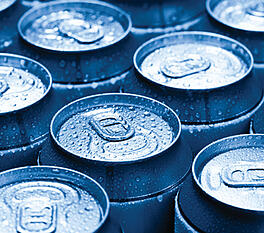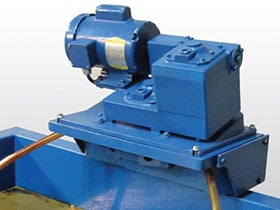Meeting Local and Federal Regulations for Wastewater Discharge
 Today, beverage canning facilities can produce 2,500 cans or more per minute on one production line using high-speed machinery. In the United States, more than 200 can manufacturing plants in 38 states produce approximately 130 billion cans each year. Aluminum beverage cans, which are the most widely used, were first introduced in the 1960’s and were the first cans to be made with only two pieces – the body and the end (or lid)¹.
Today, beverage canning facilities can produce 2,500 cans or more per minute on one production line using high-speed machinery. In the United States, more than 200 can manufacturing plants in 38 states produce approximately 130 billion cans each year. Aluminum beverage cans, which are the most widely used, were first introduced in the 1960’s and were the first cans to be made with only two pieces – the body and the end (or lid)¹.
Aluminum is widely accepted in the canning industry for several reasons, including its ability to be molded, its lighter weight, its resistance to corrosion, and its support of carbonated pressure¹. Aluminum cans are also the most cost effective to recycle, because they are 100 percent endlessly recyclable, which means that they can be recycled over and over without losing strength or quality. In a society becoming increasingly aware of its impact on the environment, being recyclable and environmentally friendly is important.
The Canning Process Does Produce Waste Oils
The canning process requires sealing the lid onto the body of the aluminum can, which is accomplished with a piece of machinery called a can seamer. A seaming head engages the lid from above, while a seaming roller curls the edge of the lid around the edge of the can body from the side. The can is rotated 365 degrees to complete the seal. Next, a pressure roller drives the two edges together, creating a gas-tight seal¹. The seamer requires constant lubrication to ensure the integrity of the seam and also to reduce part corrosion on the seamer machine. Food safety is increased by the proper operation of a can seamer, because it assures a proper seal.
Can seamers do, however, lose oil during this operation². General aviation piston engine oils were commonly used to lubricate can seamer machines in the past, and if that non-food grade lubricant entered a food or beverage can, the product was considered “adulterated,” which meant it was not fit for sale or consumption¹. Now, many companies produce food grade lubricants that can be used with can seamers and help manage food safety risks. The U.S. Food and Drug Administration (FDA) has approved incidental contact with food grade lubricants at levels up to 10 parts per million (ppm)².
How to Manage the Oil Lost by Seamer Machines
One beverage canning company installed drains in the floor that collect not only the lost oil, but also any product overflow and wastewater. The drains send the liquids to a sump, which then sends the mixture to a treatment tank. In order to meet municipal requirements for discharge, the company adds chemicals to raise the pH level.
 The oil separates to the surface of the wastewater and must be removed in order for the company to meet fats, oil, and grease (FOG) requirements for discharging the wastewater into the municipal treatment plant. Oil is removed and held in 50-gallon drums, which previously were only emptied one or two times per year. With a desire to meet regulations and become more environmentally friendly, the company decided to install an Oil Skimmers, Inc. Model 5H tube-type oil skimming system with additional decanter unit to remove a greater quantity of oil from the wastewater. Now, the 50-gallon drums are emptied at least once per month. The company hadn’t realized how little oil they were removing with their previous method, and has been very pleased with the increased oil removal. Their next step is to start recycling the oil in an effort to continue to be more ecologically aware, or “green.”
The oil separates to the surface of the wastewater and must be removed in order for the company to meet fats, oil, and grease (FOG) requirements for discharging the wastewater into the municipal treatment plant. Oil is removed and held in 50-gallon drums, which previously were only emptied one or two times per year. With a desire to meet regulations and become more environmentally friendly, the company decided to install an Oil Skimmers, Inc. Model 5H tube-type oil skimming system with additional decanter unit to remove a greater quantity of oil from the wastewater. Now, the 50-gallon drums are emptied at least once per month. The company hadn’t realized how little oil they were removing with their previous method, and has been very pleased with the increased oil removal. Their next step is to start recycling the oil in an effort to continue to be more ecologically aware, or “green.”
The EPA has found that oil skimming is an effective and environmentally conscientious method of removing oily wastes from water, reducing the discharge of pollutants. Tube-type skimmers also help companies reuse water, which reduces water consumption and thus helps businesses save money while simultaneously helping the environment through water conservation.
References
¹(2006). Complete history. Can Manufacturers Institute. Retrieved March, 9, 2011.
²Safer seaming with food grade lubricants [9]. HYFOMA. Retrieved March, 7, 2011.
